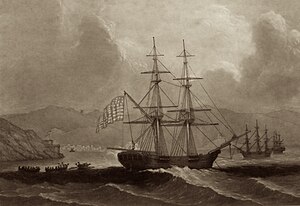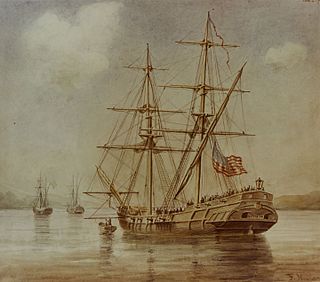
The first USS Lexington of the Thirteen Colonies was a brig purchased in 1776. The Lexington was an 86-foot two-mast wartime sailing ship for the fledgling Continental Navy of the Colonists during the American Revolutionary War (1775–1783).

David Bushnell , of Westbrook, Connecticut, was an American inventor, a patriot, one of the first American combat engineers, a teacher, and a medical doctor.
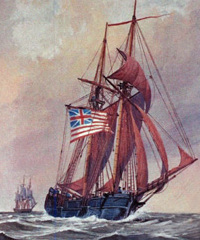
USS Wasp was originally a merchant schooner named Scorpion, built at Baltimore, and purchased under authority from the Second Continental Congress dated 2 December 1775 by Col. Benjamin Harrison sometime between 2 and 18 December 1775, the first US naval ship to be given that name. She was outfitted in Baltimore from December 1775 to early 1776; and commissioned in December 1775 or January 1776, Capt. William Hallock in command.

USS Reprisal, 18, was the first ship of what was to become the United States Navy to be given the name promising hostile action in response to an offense. Originally the merchantman brig Molly, she was purchased from Robert Morris by the Marine Committee of the Continental Congress on March 28, 1776, renamed Reprisal, and placed under the command of Captain Lambert Wickes.
Lambert Wickes was a captain in the Continental Navy during the American Revolutionary War.
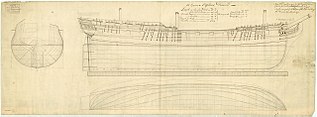
HMS Orpheus was a British Modified Lowestoffe-class fifth-rate frigate, ordered on 25 December 1770 as one of five fifth-rate frigates of 32 guns each contained in the emergency frigate-building programme inaugurated when the likelihood of war with Spain arose over the ownership of the Falkland Islands. Sir Thomas Slade's design for Lowestoffe was approved, but was revised to produce a more rounded midships section; the amended design was approved on 3 January 1771 by Edward Hawke's outgoing Admiralty Board, just before it was replaced. The contract to build the Orpheus was awarded to John Barnard at Harwich, the keel being laid in May 1771, and the frigate was launched 7 May 1773, at a cost of £12,654.16.11d. She sailed from Harwich on 24 May for Sheerness Dockyard, where she was completed and fitted out to the Navy Board's needs by 11 June.
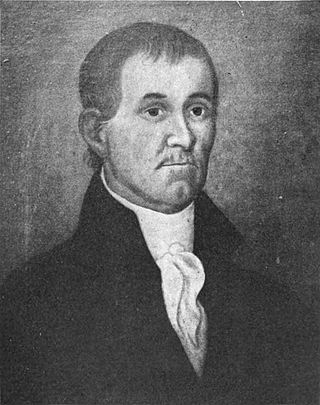
Ezra Lee was an American colonial soldier, best known for commanding and operating the one-man Turtle submarine.

1776 (MDCCLXXVI) was a leap year starting on Monday of the Gregorian calendar and a leap year starting on Friday of the Julian calendar, the 1776th year of the Common Era (CE) and Anno Domini (AD) designations, the 776th year of the 2nd millennium, the 76th year of the 18th century, and the 7th year of the 1770s decade. As of the start of 1776, the Gregorian calendar was 11 days ahead of the Julian calendar, which remained in localized use until 1923.
Events from the year 1776 in Great Britain.

The Battle of Sullivan's Island or the Battle of Fort Sullivan was fought on June 28, 1776, during the American Revolutionary War. It took place near Charleston, South Carolina, during the first British attempt to capture the city from American forces. It is also sometimes referred to as the first siege of Charleston, owing to a more successful British siege in 1780.
Hugh Montgomery may refer to:
Events from the year 1776 in the United States. This year is celebrated in the United States as the official beginning of the nation, with the Declaration of Independence issued on July 4.
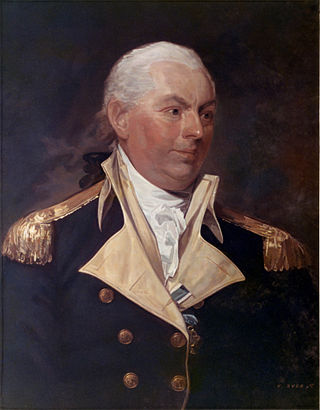
John Barry was an Irish-American officer in the Continental Navy during the American Revolutionary War and later in the United States Navy. He has been credited as "The Father of the American Navy" and was appointed a captain in the Continental Navy on December 7, 1775. He was the first captain placed in command of a U.S. warship commissioned for service under the Continental flag.

The Battle of Turtle Gut Inlet was an important, early naval victory for the Continental Navy and the future "Father of the American Navy", Captain John Barry. It was the first privateer battle of the American Revolutionary War. The battle resulted in the first American casualty of the war in New Jersey, Lieutenant Richard Wickes, brother of Captain Lambert Wickes. It was the only Revolutionary War battle fought in Cape May County.

Richard Wickes was an officer in the Continental Navy during the American Revolutionary War. He served as the third lieutenant on the Reprisal, captained by his brother Lambert Wickes. During the Battle of Turtle Gut Inlet, he was the first American casualty of the war in New Jersey.
Hugh Montgomery was an American sea captain during the American Revolutionary War. He was commander of the brig Nancy, chartered to transport military supplies for the Americans. While loading cargo in the Caribbean, he learned that independence had been declared and raised the first American flag in a foreign port, according to his daughter. Returning to Philadelphia, he prevented the seizure of the cargo of gunpowder by British blockaders at the Battle of Turtle Gut Inlet on June 29, 1776. He was later captured by the British and died in 1780 returning from New Providence after his release.

HMS Kingfisher was the second ship in the 14-gun Swan class of ship sloops, to which design 25 vessels were built in the 1760s and 1770s. She was launched on 13 July 1770 at Chatham Dockyard, and completed there on 21 November 1770. She took part in the American Revolutionary War, enforcing the blockade of the Delaware Bay, and served in the Battle of Turtle Gut Inlet, near Cape May, New Jersey. While under the temporary command of Lieutenant Hugh Christian, she was burnt by her own crew to avoid capture on 7 August 1778 in Narragansett Bay during the Battle of Rhode Island.
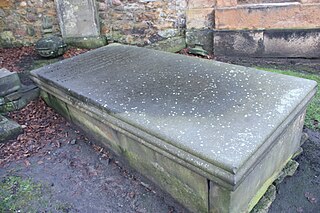
Admiral Alexander Graeme was a Royal Navy officer who became Commander-in-Chief, The Nore.
Five Mile Beach or Holly Beach is the name of a barrier island on the Jersey Shore in Cape May County. The popular resort area collectively known as The Wildwoods are on Five Mile Beach and adjacent islands.

Turtle Gut Inlet was an inlet located in what is now Wildwood Crest, in Cape May County, New Jersey, United States.
